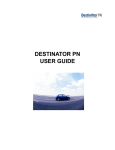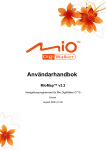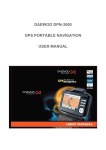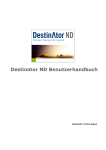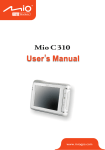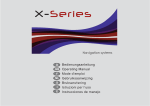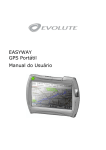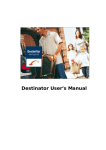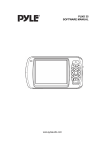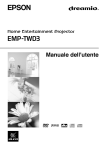Download Mio Destinator User manual
Transcript
Mio Destinator User Manual Destinator Technologies Notices, Disclaimers, and Terms of Use 1. Limited Product Warranty Destinator Technologies, warrants to the Client that the Products shall substantially conform to Destinator Technologies’ specification for a period of one (1) year from the date of the original purchase by the end user (the "Warranty Period"). As Destinator Technologies' sole obligation and Client's exclusive remedy for any breach of warranty, Destinator Technologies agrees, at its sole option, to (i) use reasonable efforts to repair the Product with new or refurbished replacement parts; (ii) replace the Product with a new or refurbished unit; or (iii) refund the purchase price, provided Client returns the defective Products to Destinator Technologies with proof of purchase and Destinator Technologies’ authorization. Destinator Technologies’ warranty hereunder does not apply in case of any damage caused by accident, abuse, misuse, misapplication, or alteration of any kind performed by anyone other than Destinator Technologies. The Products are not designed or licensed for use in mission-critical applications, or in hazardous environments, requiring fail-safe controls, including without limitation operation of nuclear facilities, aircraft navigation or communication systems, air traffic control, or life support or weapons systems. Without limiting the generality of the foregoing, Destinator Technologies specifically disclaims any express or implied warranty or condition of fitness for such purposes. Destinator Technologies’ warranty does not, in any event, apply to physical damage to the surface of the Product or replacement. Destinator Technologies shall have no obligation with respect to any data stored in the Product. Except as expressly stated in this section, Destinator Technologies makes no warranties or includes any conditions with respect to the products, express or implied, including, but not limited to, the implied warranties or conditions of merchantability, fitness for a particular purpose and no infringement. 2. Liability Limitation. In no event shall Destinator Technologies, be liable to Client, (and Client hereby waives any indirect, special, incidental, or consequential damages in connection with) the transactions contemplated by this agreement, whether or not such damages were foreseen, or their likelihood disclosed. Destinator Technologies shall not be liable to Client or any third party claiming through Client, for any damages of any kind in excess of the amounts paid by Client under the terms of this agreement with respect to the products giving rise to such damages. Some jurisdictions do not allow the exclusion of or limitation on implied conditions, warranties or damages, thus some of the foregoing may not apply to Client. 3. Intellectual Property Rights. Hardware and Software are proprietary to Destinator Technologies or its suppliers and are subject to copyright and other intellectual property laws. Client's only rights with respect to any Destinator Technologies software included with the Products shall be provided, under the terms of Destinator Technologies’ software license. The title to all Destinator Technologies Software remains with Destinator Technologies. Client agrees that Destinator Technologies retains ownership of all rights, title and interest in all intellectual property, works of authorship, trade secrets and like’s in all aspects of the Product(s). Client and its affiliates and subcontractors agree not to reverse engineer any aspect of the Software and/or Products supplied under this agreement and further agree to pay assessed damages should such action take place. 4. Copyright and Copies. The Software (including any copy thereof) is owned by Destinator Technologies or its suppliers and is protected by United States, Canada, European, Brazilian and Australian copyright and patent laws and international treaty provisions. The Software copy is licensed to you the client, not sold to you, and you (the client) are not an owner of any copy thereof. You may make one copy of the software for backup or archival purposes. You may not otherwise copy the software, except as authorized by applicable law, nor the written materials accompanying the Software. Destinator Technologies hereby reserves all rights not explicitly granted in this license agreement. Copyright © 2006, Destinator Technologies Mio Destinator User Manual Contents 1- Introduction 3 Destinator Features .......................................................................................................................................3 Tutorial .........................................................................................................................................................3 2- Getting Started 4 Destinator Menu ...........................................................................................................................................4 What's on the Map?.......................................................................................................................................9 GPS Not Found...........................................................................................................................................10 Device Buttons............................................................................................................................................10 Map Views..................................................................................................................................................10 Point on the Map.........................................................................................................................................11 Navigation Screen Buttons .........................................................................................................................12 Cycling Through Screens............................................................................................................................12 3- Search for a Location 13 Address .......................................................................................................................................................13 Recent Locations.........................................................................................................................................16 My Contacts................................................................................................................................................17 My Favorites ...............................................................................................................................................18 Food, Fuel, and Lodging.............................................................................................................................21 Turn-by-Turn List .......................................................................................................................................24 Show Route or Cancel Route ......................................................................................................................25 Avoid Roads ...............................................................................................................................................25 Traffic Information .....................................................................................................................................27 4- Settings 29 Route Planning............................................................................................................................................29 Map .............................................................................................................................................................30 Prompts .......................................................................................................................................................31 Language Settings.......................................................................................................................................32 GPS Settings ...............................................................................................................................................32 Units of Measure.........................................................................................................................................33 Quick Navigation........................................................................................................................................33 Select Map ..................................................................................................................................................34 Tutorial .......................................................................................................................................................35 About ..........................................................................................................................................................35 Free Map Browsing ....................................................................................................................................35 5- Installation Requirements 36 PC Requirements ........................................................................................................................................36 Installing the Console .................................................................................................................................36 Installing the Destinator Software...............................................................................................................36 Text to Speech (TTS)..................................................................................................................................37 Transferring a Map onto the SD Memory Card ..........................................................................................37 Console Toolbar..........................................................................................................................................38 Technical Support .......................................................................................................................................38 6- Maps 39 Map Screen Interface ..................................................................................................................................39 Installing a Map ..........................................................................................................................................40 Map Cutter Screen Interface .......................................................................................................................41 Focus the Map.............................................................................................................................................42 Mio Destinator User Manual i Introduction Cut Map ......................................................................................................................................................43 Load Map....................................................................................................................................................43 Remove Map...............................................................................................................................................43 7- Importing a Favorite 44 Favorites Importing File Structure..............................................................................................................44 Importing a .CSV File.................................................................................................................................45 Index Mio Destinator User Manual 46 ii 1 - Introduction Welcome to the world of mobile navigation! Your Destinator device provides a full-featured mobile satellite navigation system. Gone are the days of “taking out the map”. You can now select an address or a predefined point of interest and request your navigation device to create a route. Destinator Features Destinator provides the following features for easy navigation: Able to install and use your navigation device in minutes Full screen 2D/3D day and night maps with precise voice guidance Able to quickly create a route for any distance View your route by a demo program that moves the location icon from the current location to your selected destination before starting navigation Navigate by selecting an address from the Contact folder Cross border navigation without switching maps Intuitive menus and touch-screen buttons for easy input Instant address retrieval from recent locations, favorite destinations, or points of interest Avoid toll roads, congested roads, or roads through dangerous areas Provides traffic messages alerts A wide selection of maps from all over the world A choice of over 3 languages Attractive map and screen format Totally portable, and can be used in a vehicle during your daily commute or on vacation Tutorial From the Settings menu, you can tap the Tutorial button to open the Destinator Guide Tour program. The Guided Tour is an excellent way of becoming familiar with the different navigation features available. Mio Destinator User Manual 3 2 - Getting Started Destinator Menu When you start Destinator, the Destinator menu appears, as shown below. Figure 1 – Destinator Menu Note: When you have the Main Map screen displayed, you can press the Menu the Destinator menu. button to display Address Screens The Address button lets you navigate to an address, as shown below. Figure 2 - Address Menu Button For a complete description of how to navigate to an address, see "Enter Address" on page 13. Mio Destinator User Manual 4 Getting Started My Places Menu When you click the My Places button, the following menu appears. Figure 3 - My Places Menu Button The My Places button lets you: • Specify an address or place to which you can navigate with a single tap on the Home button. For more information, see "Set Quick Navigation" on page 33. • Navigate to a favorite location by tapping the My Favorites button, as described in "My Favorites" on page 18. • Navigate to a previously visited destination by tapping the History button, as described in "Recent Locations" on page 16. • The My Contacts button lets you navigate to an address saved in your Contacts folder, as described in "My Contacts" on page 17. Mio Destinator User Manual 5 Getting Started Food, Fuel, Lodging Menu When you tap the Fuel, Food, Lodging button, the first screen of popular place categories appears, as shown below. Figure 4 - Food, Fuel, Lodging Menu Button The Food, Fuel, Lodging button lets you navigate to thousands of interesting places, such as beaches, parks, hotels, museums, and restaurants. For more information, see "Food, Fuel, Lodging" on page 21. Map, Look & Feel Menu You can tap the Map, Look & Feel button to determine the map display and to show the generated route after you have selected a location. The Map, Look & Feel menu is shown below. Figure 5 - Map, Look & Feel Menu Button The Map, Look & Feel screen lets you: • Display the map in 2-dimensional or 3-dimensional views for either day or night driving by tapping the 2D/3D Mode toggle button. For more information, see "Map Views" on page 10. Mio Destinator User Manual 6 Getting Started • Display the map view for either day or night driving by tapping the Day/Night Mode toggle button. For more information, see "Map Views" on page 10. • Avoid toll roads or selected streets by tapping the Avoid Roads button, as described in "Avoid Roads" on page 25. • Monitor traffic information and avoid congested roads by tapping the Traffic Info button. For more information, see "Traffic Information" on page 27. • Display complete, step-by-step directions to your destination by tapping the Turn-by-Turn button. For more information, see "Turn-by-Turn" on page 24. This button is disabled when no route exists. • Display your complete route on the Main Map screen by tapping the Show Route button. This button is disabled when no route exists. Settings Menu The Settings button, at the bottom of the My Places and Map, Look & Feel menus, lets you configure your settings options. The first Settings menu is shown below. The Settings button lets you: • Specify the route type, Quickest or Shortest, and whether to allow for U-turns. For more information, see “Route Planning” on page 29. • Specify map orientation, font, and zoom features by tapping the Map Settings button. For more information, see "Map Preferences" on page 30. • Specify voice or visual prompts that you want to use by tapping the Prompts button. For more information, see "Prompts" on page 31. • Select the language for announcing travel prompts, and displaying street names and driving directions by tapping the Language button. • Display the GPS configurations by tapping the GPS Signal button. For more information, see "GPS Status" on page 32. • Specify the system measurement units by tapping the Units of Measure button. For more information, see "Units of Measure" on page 33. • Select an address or place to which you can navigate with a single tap on the Home button, located in the My Places menu. For more information, see "Quick Navigation" on page 33. • Choose among different maps on your memory card by tapping the Select Map button. For more information, see "Select Map" on page 34. • Open the Destinator Guided Tour program by tapping the Tutorial button. • Display copyright and Destinator version information by tapping the About button. Destinator Menu Buttons Mio Destinator User Manual 7 Getting Started The Map button displays the Main Map screen. The Cancel Route button stops the current navigation and clears the route. The MP3 button lets you switch from the Destinator Navigation System to the MP3 player. The More button lets you move to the second menu screen. The Back button lets you move to the previous menu screen. The Settings button, at the bottom of the My Places and Map, Look & Feel menus, lets you configure your settings options. The Help button displays technical support information. Mio Destinator User Manual 8 Getting Started What's on the Map? When you tap the Map button on the Destinator menu screens, the Main Map screen appears. You can use the icons displayed on this screen to view your route. Directions Bar Current Location Compass Zoom In Zoom Out Menu Button Volume GPS-Generated Information Figure 6 - Map Screen Your current location. Your last known location when the GPS signal is unreliable. The generated route. Your selected destination. The Compass displays the travel direction. The GPS bar is a toggle button that displays the remaining travel distance and travel time, estimated time of arrival, and speed and altitude, and street name and address number. When you have calculated a route, the Directions bar displays information about your next turn. Click this bar for a complete list of turn-by-turn directions. Mio Destinator User Manual 9 Getting Started GPS Not Found When you first start your navigation device, you will hear the message “Signal too low”. This message means that your navigation device hasn’t yet located a reliable GPS signal. Check that your device is connected and has a clear view of the sky. If after five minutes, you have not located a reliable signal, go to the “Technical Support” section on page 38. Please check that: • The device has a clear view of the sky for uninterrupted GPS reception. Destinator cannot calculate the route if there is no GPS reception (for example, in a tunnel). • The navigation device is charged or connected to the cigarette lighter. Device Buttons You can use the following device buttons, located on the right-side of the device: This button turns on the device This button displays the Destinator menu + This button lets you increase the volume. – This button lets you decrease the volume. Map Views You can determine whether you want to see a two-dimensional or three-dimensional map in daylight or nighttime conditions. The 2D Day Mode View is optimized for a daytime viewing. 2D views let you manually pan or zoom. For an example, refer to Figure 2 - 2D Day Mode Map View. The 2D Night Mode View is optimized for night driving or adverse weather conditions. For an example, refer to Figure 3 - 2D Night Mode Map View. The 3D Mode Day View or Night View provides you with a three-dimensional map for day or night driving. For an example, refer to Figure 4 - 3D Day Mode Map View and Figure 5 - 3D Night Mode Map View. From the Map, Look & Feel menu, click the 3D Mode button to view a three-dimensional map. If the map already appears in three-dimensions, 2D Mode button. You can click the Night Mode already appears in night mode, Day Mode Mio Destinator User Manual is displayed on the toggle button to display the map in night conditions. If the map is displayed on the toggle button. 10 Getting Started Figure 7 - 2D Day Mode Map View Figure 8 - 2D Night Mode Map View Figure 9 - 3D Day Mode Map View Figure 10- 3D Night Mode Map View Point on the Map You can navigate to any point by tapping its location directly on the Main Map screen. This feature is especially handy when you want to navigate to a specific point on the map, but you don’t have the street address. When you tap on the map, the context menu appears. Go There – This button lets you calculate a route from the map point. Add to My Favorites – This button lets you save a point on the map as a favorite destination. This feature lets you quickly save a location that you would want to return to later. Set as Origin –This button lets you designate the selected point as the starting point and not the designation. Figure 11 - Point on the Map Options Mio Destinator User Manual 11 Getting Started Navigation Screen Buttons The following buttons appear on many of the Destinator navigation screens. When you tap the Next button for a selected address, group, or place, Destinator automatically opens the next screen in the sequence. After you have specified your destination, tap the Next button to display a map screen showing your selected location. This map lets you determine a route type and provides a GO! button, which instructs Destinator to calculate the route from your current location to your selected destination. When you tap the Back button, Destinator returns you to the previous screen. When you tap the GO! button, Destinator calculates the route to your selected destination. The Actions button provides a list of command options available for the selected address or place. The Hide/Display Keyboard toggle button lets you show or remove the keyboard. The Save, OK, or Done buttons confirm your value preferences and returns you to the menu or map. Cycling Through Screens Every navigation function in the system, such as Address, Food, Fuel, Lodging, or My Favorites consists of a sequence of screens. You can cycle through the screen sequences by either: Selecting an item from the list and tapping it. Selecting an item form the list and tapping the Next button. The sequence ends with the Show on Map screen, where the destination is displayed and the GO! button is available for you to calculate a route. You must first select an item from the list to cycle through the screen sequence, and for the Actions, Next and Back buttons to be enabled. Mio Destinator User Manual 12 3 - Search for a Location Address When you click the Address button, the Address screen appears, as shown below. 1. Enter Address 2. State 3. City 4. Street 5. Address Number Figure 12 - Display the Address Screen You can use the keyboard to enter the first characters of the address name. The characters appear in the Address field. Destinator automatically searches the Address list for the first occurrence of the entered characters. After you have selected a city, Destinator displays the next address field, such as street and address number. You can also tap the Next button to move through the sequence of address screens. The following command keys are available to enhance your search process: If the automatic search feature does not find your specified name, use the Find button to conduct a sub-search, particularly useful when the address name consists of two or more words. The Scroll buttons let you move up or down the list of address items, such as city or street names. The Hide/Display Keyboard toggle button lets you extend or shorten the address list by hiding or displaying the keyboard. The Select key lets you display numeric characters. You can tap the Umlauts button to display a keyboard of umlauts characters. Mio Destinator User Manual 13 Search for a Location The Erase key lets you delete the last character in an address field. You can change your address search method by tapping the Mode button to select from a variety of address formats, as described in "Address Modes". Note: If the entered characters are not found at the beginning of the name in the Address list, the Smart Search System automatically searches for the entered characters throughout the entire list, for example, in the middle or the end of the name. Destinator lets you search for city and street names without having to enter accent marks (umlauts), which are used in many European languages. Address Modes You can define the information used to locate an address by tapping the Mode button. Destinator provides a variety of address formats, as described below. City-Street This sequence displays the following address screens: City, Street, Address Number You can also navigate to city or street only. When you have selected a city, the first entry of the Street Name list is City Center. When you have selected a street, the first entry in the Address Number list is Street Midpoint. City-Street is the default format. Street-City This sequence displays the following address screens: Street, City, Address Number Lets you enter a street name without having to first designate a city. Useful when you're looking for an address in a metropolitan area where there are many cities and towns. Cross-Street This sequence displays the following address screens: City, Street 1, Street 2 Lets you locate an intersection by entering the names of two intersecting streets. Zip Code This sequence displays the following address screens: Zip Code, Street, Address Number This mode lets you locate a street address by entering the zip code, without entering a city name. Useful when you have no city information or if the city has multiple zip codes. Mio Destinator User Manual 14 Search for a Location Address Actions When you have specified an address, tap the Actions button to select from the following commands: Set as Origin Lets you designate the selected address as the route origin. Use this command when calculating a route from a point other than your current location. The navigation device displays the selected location as a starting point only for a few seconds before returning you to your current location. Note: You are still receiving the GPS signal. Show on Map Lets you see the selected address on the map. Add to My Favorites Lets you add an address to your list of favorite locations, as shown in the figure below. For more information, see "My Favorites" on page 23. Figure 13 - Add Address to My Favorites Go to your Destination After you have specified the address, tap the Next button. Destinator shows your destination on the Map screen before calculating a route. Check that the destination address is correct at the top of the screen. If you want to change the destination, tap the Back button and change your address entries. When you are ready, tap the GO! button to create a route to your selected destination. 1. Next Screen 2. Show on Map 3. Calculate Route Figure 14 - Calculate your Destination Mio Destinator User Manual 15 Search for a Location Demo Route When you click the Demo button, Destinator moves the cursor along the path you would take to your destination, as shown below. Figure 15 - Demo Route You can review the route you would go on before instructing Destinator to calculate your route and specify roads to avoid by tapping the Avoid Roads button on the Map, Look & Feel menu. For more information, see “Avoid Roads” on page 25. Recent Locations The Recent Location screen lets you select an existing destination from a list of destinations that you have previously traveled to. Destinator automatically stores the last 64 destinations in memory. As each new route is added to the top of the list, the older destinations at the bottom are erased. To navigate to a recently-traveled destination, tap the History button on the My Places menu. From the Recent Locations screen, select a location and tap the Next button. A map appears showing the specified location. Tap the GO! button to calculate the route. 1. Opens Recent Locations 2. Recent Locations 3. Next Screen 4. Show on Map Figure 16 -Traveling to a Recent Location Mio Destinator User Manual 16 Search for a Location From the Recent Locations screen, you can tap the Actions button to select from the following commands. Set as Origin Lets you designate the selected address as the route origin. You would use this command when calculating a route from a point other than your current location Note: You are still receiving the GPS signal. Add to My Favorites Lets you add an address to your list of favorite locations. For more information, see "My Favorites" on page 23. Delete Item Lets you delete a recent location. Clear List Lets you clear all locations in the Recent Locations screen. My Contacts You can specify a contact address as a destination, by selecting a contact from your PC folder, found under the Start menu. From the My Places menu, click the My Contacts button to display your list of contacts. Select a contact and click Next to display the addresses entered for the contact. From the Contact Address screen, tap Next to display the similar addresses that are recognized by Destinator. Select a Destinator address and click Next to show the location on the map. Tap GO to instruct Destinator to navigate to the selected address. 1. Open Contacts List 2. Select Contact 3. Contact Address 4. Destinator Addresses 5. Show on Map Figure 17 - Locating a Contact 's Address Mio Destinator User Manual 17 Search for a Location When you tab the Actions button, you can choose from the following options: Add to Favorites Lets you add the specified address to your list of favorite locations, as shown in the figure below. Set as Origin This button lets you designate the selected address as your point of origin. This is helpful when you want Destinator to calculate a route from a point other than your current location. My Favorites A Favorite is a destination that you have stored for easy retrieval. To access a favorite destination, open the My Places menu and tap the My Favorites button. The My Favorites screen displays your favorites groups. When you tap on a selected group, Destinator automatically displays its stored locations. Tap the selected location to show your destination on a map. Tap GO! to calculate your route. 1. Opens My Favorites 2. Favorites Groups 3. Favorites Locations 4. Move to Next Screen 5. Show on Map Figure 18 - Travel to a Favorite Location Note: The MY FAVORITES folder is the default folder where all favorites are stored if not assigned to a group. Mio Destinator User Manual 18 Search for a Location Favorite Groups You can tap the Actions button from the My Favorites screen to add, edit, or delete groups, as described below. Add Group When you tap this button, the Favorites Group screen appears. Enter the group name and select an icon to identify the group, as shown below. Figure 19 - Create Favorites Group The icon identifies all destinations located in that group, as displayed on the map. Edit Group When you tap this button, the Favorites Group screen appears with the name and selected image of the highlighted group. You can change the name and icon. Delete Group When you tap this button, the selected group and its associated entries are removed. The My Favorites group cannot be deleted. Favorite Alerts Alerts let you know that you are within a certain distance of a favorite location. You can tap the Alerts button to set the distances for the 1st and 2nd Alerts. When you travel closer than the designated distance, the alert will sound, as shown below. Figure 20 - Setting Your Favorite Alerts Mio Destinator User Manual 19 Search for a Location Examples: You have a group called “Shopping” that includes all of your favorite stores. An alert appears on the screen when you are closer than the designated distance to the stores in your group, providing an opportunity to consider whether you would like to stop and shop. You have a group called “Projects” that include addresses of your bank, grocery store, garage, hardware store, doctor’s office, post office, and so on. When the alert is set, Destinator reminds you about these places when you come within close proximity to them. You are going on a trip and friends have recommended certain restaurants that are on your route. You can create a group called “Restaurants” and enter the restaurant addresses. As you take your trip, an alert will go off when you come within range of these restaurants. Notes: Favorite Alert settings affect all Favorites Groups. The 2nd Alert must be set to go off at closer distance than the 1st Alert. Alerts can be set for a group but not for individual locations. Of course, you can always create a group that has just one location. You can disable the alerts for all groups by selecting the 1st Alert setting to Off. You can disable the alerts for a particular group by selecting the group and tapping the Show/Hide Symbol on Map toggle button. Disabled alerts are identified by a red diagonal line through the symbol. Figure 21 - Disabling an Alert for a Group Activate that disabled alert by selecting the group and tapping the Show Symbol on Map button. Add Favorite Locations Tap MY FAVORITES or any selected group that you have created to display its locations. You can save a location to your favorites groups from the Address, Recent Locations, or POI screens. For more information, see "Add to Favorites" on page 15. Mio Destinator User Manual 20 Search for a Location From this screen, you can tap the Actions button to display the following commands. Set as Origin Lets you designate the selected location as the route origin. You would use this command when calculating a route from a point other than your current location. Note: You are still receiving the GPS signal. Show Map Lets you see the map with the selected favorite destination for you to review before creating a route. Edit Favorite Location Lets you change the name, comment, or group location for the selected location. Delete Favorite Location Tap the button to remove the selected location. Food, Fuel, and Lodging The Food, Fuel, and Lodging list is a collection of hundreds of interesting or useful places organized by easy-to-find categories. For example, you can use Destinator to guide you to a mall, hotel, restaurant, or gas station. From the Destinator menu, tap the Food, Fuel, and Lodging button. The first Food, Fuel and Lodging Popular Category screen appears, as shown below. Figure 22 - Popular Categories The More button located on the second Food, Fuel, Lodging screen displays the list of all categories, as shown below. Figure 23 - All POI Categories Mio Destinator User Manual 21 Search for a Location You can find a category by tapping the Hide/Display Keyboard button and entering text in the POI Category field. The Smart Search System automatically displays the POI categories that match the characters entered. If you didn’t find the category through the initial search you can also use the Find button to do a sub-search, particularly useful when the category name consists of two or more words. You can always browse the POI Category list by using the Browse buttons. When selecting a category, Destinator automatically displays the category entries and the distance each entry is from your current position. Select your entry and tap or click the Next button to display your selected destination on the map and then tap GO to calculate your route. 1.POI Categories 2. POI Locations 3. Show on Map Figure 24 – Points of Interest Note: From the Item Entries Actions screen, click the Sort by ABC button to display the category entries in alphabetical order. Subcategories Many categories have subcategories to provide for an even greater list of choices. For example, “Gasoline Station” may have many subcategories each representing a particular brand name. The same is also true for “Hotels”. “Restaurants” have subcategories that represent different types of food, such as American, Italian, and French, as shown below. Figure 25 - POI Subcategories Search Near a Location You can tap the Near button to determine the location area, where you want to search for a specific place, such as a gas station, hotel, or restaurant. The available options are listed below. Current Location Mio Destinator User Manual Lets you search near your current location. This is the default value. 22 Search for a Location Destination Lets you search near a specified destination. For example, you know your general destination, but not very much about interesting locations in the area. You can use Destinator to locate the tourist attractions most appealing to yourself, family, or friends. Note that this button is enabled only when a destination is entered. Other Address Lets you search near another address. For example, you have set a destination, but on the way you want to stop at another location. You can use this feature to search near that location for restaurants, lodging, historical sites, or anything you want. Search Radius Enter the location distance to search for a designated place. For example, if you enter 5 km, Destinator only searches within a five kilometer radius. When you select a large search radius, you risk the chance of finding too many locations, which makes it harder to find the place that you are searching for. It is best to start with a small search radius size, and then make it larger if necessary. Note: if you don’t specify a search radius, Destinator searches the whole map. Show or Hide Symbol on Map Lets you customize your POI list by showing or hiding the POI category symbols that you don’t want. When you hide a category a red mark appears. This mark only means that the category symbol does not appear on your map. The category locations are still available to you. You can always show a hidden category symbol by selecting the category and tapping the Show Symbol on Map button. Actions When you have selected a POI location, tap the Actions button to display the commands listed below. Set as Origin Lets you designate the selected location as the route origin. You would use this command when calculating a route from a point other than your current location. Note: You are still receiving the GPS signal. Show on Map Lets you show the map with the displayed destination for you to review before creating a route. Add to My Favorites Lets you add a POI entry to your list of favorite locations. For more information, see “My Favorites” on page 23. Sort By ABC or Distance Lets you sort the entries of the selected category alphabetically or by distance from your current location. Note: Destinator initially displays the entries by distance. Mio Destinator User Manual 23 Search for a Location Turn-by-Turn List After you have entered a destination and calculated a route, the Directions bar appears at the top of the Map screen, displaying the following information: • The next turn direction • The distance to the next turn • The street name of the next turn button on the Map, Look & Feel When you tap the Directions bar or click the Turn-by-Turn menu, Destinator displays a complete set of turn-by-turn directions from your current point to your selected destination. Use the Scroll buttons to move up or down the directions list. Figure 26 - Display Turn-by-Turn The following options are available: The Route Summary button displays your entire route on the Map screen, plus the travel distance and the Estimated Travel Time Remaining (ETR). The Show Turn button displays the next turn on the Map screen, including the street name, the distance to it, and the turn direction. The Avoid button lets you avoid the selected turn in the directions list. Destinator recalculates the route automatically. Note that when you exclude a turn, the recalculated route may take longer. Mio Destinator User Manual 24 Search for a Location Show Route or Cancel Route From the Map, Look & Feel menu, you can tap the Show Route button lets you display an overview of your complete route on the Map screen, the total driving distance to your destination, the estimated travel time, and the complete destination address. Figure 27 - Show Route From the Destinator menu The Cancel Route button stops the current navigation and clears the route. This button is active only after a destination has been set. Avoid Roads You can specify that certain roads be permanently excluded from your route calculations. Use this feature when you want to avoid congested boulevards, toll roads, or unsafe streets. From the Map, Look & Feel menu, tap the Avoid Roads button. The Avoid Roads screen appears, displaying the Toll Roads and Avoid Road groups. 1. 2. Displays Groups 3. Add Group 4. Enter Group Name Figure 28 – Creating Avoid Road Groups Avoid Road Groups From the Avoid Roads screen, tap the Actions button. The Actions screen lets you select from the following commands: Mio Destinator User Manual 25 Search for a Location Add Group Create a new a group of roads to avoid. For example, you can create a group called “San Francisco Roads”, where you designate the roads in that area to be avoided. When you tap the Add Group button, the Avoid Roads Group screen appears. Enter the group name and tap Save. Edit Group Select a group and tap this button to change the group name. When you tap the Edit Group button, the Avoid Roads Group screen appears displaying the group name. Change the group name and tap Save. The new name is displayed on the Avoid Roads screen. Delete Group Select a group and tap this button to remove the group from the Avoid Roads screen. The road entries in this group are also removed. When selecting a group route, you can tap the Allow exclude all roads located in the group. or Avoid button to include or Avoid Road Locations When you tap Default or an Avoid Roads group, Destinator displays the group screen, which lets you select roads to avoid. From this screen, you can use the Allow or Avoid buttons to include or exclude a selected road when calculating a route. 1. Displays Roads 2. Add Road 3. Enter Road Name 4. Show on Map Figure 29 - Adding a Road to Avoid Note: You cannot specify a particular toll road. Mio Destinator User Manual 26 Search for a Location You can tap the Actions button from this screen to select from the following commands: Add Road Lets you select a road. An address screen appears for you to specify a city and street. When you have completed updating your road information, tap Save. Edit Road Lets you rename the road and select a different group. When you have made your changes, tap Save. Delete Road Select a road and tap this button to remove the road from your group. Destinator no longer recognizes the removed entry as a road to avoid. Show on Map Lets you show the map with the displayed destination for you to review before creating a route. Traffic Information TMC messages are national and regional public radio FM transmissions that are used to inform drivers of traffic, weather, and other driving conditions. TMC information is received by your TMC-enabled GPS receiver and monitored by your software. Destinator can automatically reroute your travel to avoid areas that TMC indicates are troublesome to drivers. For instance, if there is a storm or accident in your vicinity, your route would be recalculated to avoid the problem. Please check whether your area supports TMC broadcasts. A TMC receiver is required to receive TMC broadcasts. From the Map, Look & Feel menu, select the Traffic Info button, which opens the TMC inbox, and displays traffic reports. You can select a traffic report and click Next to show a map of the affected road. If you click the Avoid button, Destinator recalculates your route. The Radio Frequency bar, at the top of the TMC screen, displays the radio station frequency. You can tap the Actions button to disable the TMC Auto-Search button, so that your TMC messages are from only one station. If the TMC Auto-Search is disabled, you can click the same button to enable the TMC AutoSearch, so that your messages appear from many stations. You can use the following buttons to go to a different radio frequency: Lets you search for a traffic channel at a lower frequency. Lets you make minimal steps toward a lower frequency to bring in the channel Lets you make minimal steps toward a higher frequency to bring in the channel Lets you search for a traffic channel at a higher frequency Channel Auto-Search Tap the Actions button to show the Channel Auto-Search toggle button. When you tap this button, Destinator automatically searches through the entire range of frequencies until a traffic channel is located and continues to search for a traffic channel whenever the previous traffic channel frequency is lost. Mio Destinator User Manual 27 Search for a Location TMC Options You can tap the Options button to configure the TMC feature, as listed below. Message Arrives You can select either: Avoid Automatically - Destinator automatically recalculates the route to avoid a road with adverse traffic conditions. Ask Me - You must manually select the TMC event from the inbox and tap the Avoid button from the Show Map screen. The advantage to this option is that you maintain control over your route. Traffic Alert Categories You can select from the following traffic message types: • Accidents • Weather • Information • Traffic Jams • Construction TMC Distance You can determine the radius size to monitor for traffic messages. Mio Destinator User Manual 28 4 - Settings From the My Places or Map, Look & Feel menus, you can tap the Settings button to display the Settings menus, as shown below. Figure 30 - Settings Menus Route Planning You can tap the Route button from the Settings menu to specify the route type and whether to allow for U-turns, as shown below. If the destination is correct, you can instruct Destinator how to calculate your route by tapping either the Quickest route or Shortest route options, as described below. Route Planning The Quickest route option selects the route that takes less time. Quickest route is the default value. The Shortest route option selects the route that is the shorter distance. Remember, the shorter route may not always be the quickest, as you are able to travel faster on some roads than on others. Note: Route generation does not take into account any detours, stops, or delays along the route. Mio Destinator User Manual 29 Settings Map You can click the Map Settings button from the Settings menu to customize your map display, as shown in the figure below. Figure 31 - Map Settings The following map settings are: Map Orientation Forward is up – This option orients the map so that your forward direction is always at the top. North is up – This option orients the map so that North is always at the top. Use Automatic Zoom When this option is selected, the zoom is speed dependent. The map zooms out at higher speeds, displaying a larger map area, and zooms in at slower speeds, displaying a smaller map area. If you manually change the zoom, the Automatic Zoom returns to its system level after several seconds of inactivity. Use Larger Print This option increases the size of street names to make the map easier to read. Mio Destinator User Manual 30 Settings Prompts You can select the types of voice and visual notifications that you would like to use while navigating. From the Settings menu, tap the Prompts button. The Prompts screen appears, as shown in the figure below. Figure 32 - Prompts Settings Voice Prompts Speed Warning This prompt warns you when your car exceeds the speed limit. This prompt is not active unless selected. Route Recalculation This prompt is activated when Destinator recalculates a new route. This prompt is not active unless selected. Unreliable GPS Signal This prompt warns that the GPS signal is too low and unreliable for navigation. This prompt is automatically active. Drive Carefully This is a friendly reminder at the start of each journey. This prompt is automatically active. Visual Prompts Text Directional prompts are displayed in written form. Symbols Directional prompts are displayed in diagram form, such as an arrow. None Directional prompts are not displayed. Mio Destinator User Manual 31 Settings Language Settings This screen lets you select the language for announcing travel prompts, street names and driving directions. You can also select the type of voice, such as American, British, French, German, and so on. - Language Settings GPS Settings Destinator uses the GPS receiver to pinpoint your location. GPS signals are automatically acquired and your vehicle's location and position are constantly updated. The GPS may take a few minutes to find its initial location. For best results, ensure that the GPS has a clear view of the sky. Figure 33 - GPS Status This screen displays the following GPS information: Longitude - The angular distance east or west on the earth's surface, as measured in degrees from the meridian of a particular point to the prime meridian of Greenwich, England. Latitude - The angular distance, measured north of south from the equator, of a point on the earth's surface. Speed - The rate of movement, as expressed by kilometers or miles per hour. Altitude - The height above sea level. The green lines that appear on the satellite image represent the satellites that are sending GPS signals to your receiver. Mio Destinator User Manual 32 Settings Units of Measure From the Settings menu, click the Units of Measure button to specify the system’s units of measurement. Figure 34 - Units of Measure You can select: Imperial – Yards or miles Metric – Meters or kilometers Quick Navigation You can define the Quick Nav. location by selecting either the To Predefined Address or To Nearest POI Category in the Quick Nav. Settings screen. When the location is selected, you can navigate to your address by tapping the Home. button displayed on the Map, Look & Feel menu. For example, if you have selected "Hospitals" as the Quick Nav. destination, when you click the Home button, Destinator automatically creates a route to the closest hospital or clinic. Figure 35 - Setting the Quick Nav. Location Mio Destinator User Manual 33 Settings Select Map This feature lets you change the currently selected map to another map saved on your SD memory card. If you want to store additional maps on your memory card, see “Maps” on page 39. You can tap the Select Map button from the Options menu to display the maps saved on your SD memory card. The Select Map screen displays map details and version numbers. The map currently used appears at the top of the list. Figure 36 - Select a Map The following Select Map commands are: Select Lets you designate a selected map as the current map. Delete Lets you permanently remove a selected map. Note: You cannot delete the current map. Refresh Lets you refresh the screen when a new memory card is inserted into the device. Mio Destinator User Manual 34 Settings Tutorial Tap the Tutorial button to open the Destinator Guide Tour program. The Guided Tour is an excellent way of becoming familiar with the different navigation features available. About Tap the About below. button to displays Destinator version and copyright information as shown Free Map Browsing This feature lets you browse the map without the GPS receiver returning you to your current location. Tap the Browse the Map button to disconnect from the GPS receiver. When you are ready to reconnect to the GPS receiver, go to the Settings menu and tap the GPS Signal button. From the GPS Status screen, tap the GPS On button. Mio Destinator User Manual 35 5 - Installation Requirements Destinator is already installed on your proprietary device, but to add or change maps, you are required to install the MioMap Destinator Console on to your PC. PC Requirements To install and use the Console, your PC must meet the following requirements. Microsoft Windows 98, ME, NT, 2000, or XP A minimum of 300 MB free space for temporary files An Internet connection for online registration Installing the Console To install the Destinator Console: 1. Insert the Destinator Disk into the PC's CD-ROM drive. The Destinator Console Installation Wizard prompts you to select the language used for the installation process. When you have selected a language, click OK. 2. Please read the Welcome message and click Next. 3. From the Select Directory screen, either accept the recommended default directory or browse to a different directory to install the Destinator Console. Click Next. 4. From the Language screen, select the default language. Click Next. 5. The Installation Confirmation screen displays your installation choices. If you are ready to install, click Next. The Installation Status box displays the progress of the installation process. 6. If you want to change the language selection or the directory location before installing, click Back, make your changes, and return to the Installation Confirmation screen, and click Next. 7. When the installation is complete, click the Finish button to close the wizard. You can open the console by clicking MioMap>MioMap Console from the Windows Programs menu. Installing the Destinator Software To install Destinator: 1. Insert Destinator Disk into the PC’s CD-ROM drive and launch the Destinator Console from the Start menu select Start > Programs > MioMaps > MioMaps Destinator Console 2. Check that MioMaps proprietary software is loaded and running. Verify that the device is connected to the PC. 3. Click the Install Software 4. The End-User License Agreement (EULA) is displayed. Please read it carefully and click Yes, I Agree. 5. Destinator prompts you to specify an installation directory. Click Yes to select your device’s default application installation directory. Click No, if you want to specify another device directory. The Select Directory dialog box appears. Browse to a directory in your device and click OK. 6. The Installation Applications status box displays the progress of the Destinator installation. 7. The Information message box refers you to the device screen for instructions. Mio Destinator User Manual button to install Destinator to your device. 36 Installation Requirements 8. When Destinator has been successfully installed, the Successful Installation message box appears. Transferring a Map onto the SD Memory Card 1 Connect the device to your PC. 2 Select the required map (Be aware of the size of your memory card). Click Change (bottom right) and select Storage Card. 3 Click Install/Remove Maps on the toolbar. A Map Loading Indicator is shown. 4 A confirmation message appears when the map has been installed. Console Toolbar The following options are available from the MioMap Console Toolbar: This button lets you install the Destinator Navigation System to your device. This button lets you install or remove a map. For more information, see “Installing a Map” on page 40. This button lets you customize an installed map. For more information, see “Map Cutter Screen Interface” on page 41. This button lets you download a list of your favorite locations from your PC to the selected My Favorites group on your device. For more information, see “Importing a Favorite” on page 44. This button lets you configure the Destinator Navigation System so street names are included in the voice prompts. This button lets you activate your Destinator Navigation System through an automated process. This button lets you backup your Favorites, Route Groups, or My Destinator settings. When you click the Backup button, the Favorites folders, MPR, and the Destinator.ini file are copied to: [X]:\Destinatorapps\Backup [X] represents the drive letter where Destinator is located on the user’s PC. If these folders already exist on the PC, the following message appears: Warning, an older backup exists on this computer. Overwrite? Mio Destinator User Manual 37 Installation Requirements This button lets you restore your Favorites, Route Groups, and My Destinator settings. When you click the Restore button, the Console takes the information stored in [X]:\Destinatorapps\Backup and returns these folders to their appropriate locations on the device. If an equivalent folder is already on the device, the Console returns the folder with the extension label, “old”. Technical Support If you have other questions about the Destinator Navigation Device, please contact your supplier or Technical Support: Web Site: http://www.miogps.com. Toll Free number: 1-866-MIO-4-GPS. Mio Destinator User Manual 38 6 - Maps When you receive your device, Destinator is installed on your SD memory card along with a series of maps. This section provides information about installing additional maps from the MioMap Console, as shown below. For information about installing the Destinator Console, see “Installation Requirements” on page 36. Map Screen Interface On the Destinator Console, a collection of maps is displayed. Standard Maps Maps available for installation from your CD. My Maps Maps that you have customized from a standard map. For example, creating a map of London from the standard map of the United Kingdom and Ireland. Installed Maps Current maps on your SD memory card. Mio Destinator User Manual 39 Maps Installing a Map You can install a map by selecting it from the Standard Maps pane in the Destinator Console and clicking the Install/Remove Maps button. The Target Device dialog box appears. Select Storage Card. The amount of memory available for the SD memory card appears on the Target Device Memory Balance pane. The installed map appears in the Installed Maps pane. 1.Select Map 3.Loading Map 4. Target Device and Space 5. Installed Maps 2.Click Install Map Figure 38 - Installing a Map Mio Destinator User Manual 40 Maps Map Cutter Screen Interface Due to memory limitations of your SD memory card, you may want to customize a standard map by selecting the area you need. For example, if you are visiting a number of European cities on business, you may not want to install entire maps of those countries. You can crop a standard map from the Destinator Map Cutter screen. Select a standard map and click the Cut Map button. The Map Cutter screen appears, as shown in the figure below. Figure 39 - Using the Map Cutter Mio Destinator User Manual 41 Maps The following tools are provided to help you easily move, view, and designate an area on the map: You can use the Pan tool to move the map up, down, left, or right. You can use the Zoom tool to increase or decrease the map detail. You can also use the scroll bar to zoom in or out. You can use the Crop tool to designate an area on the map that you want to cut. When you have selected your focus by using the focus tools, as described below, click the Crop tool to designate an area on the standard map. You can use the Cut tool to create a customized map from your designated area. Focus the Map The following tools are provided to help you center your map, so you can designate the area that you want to cut. For example, perhaps you want the Center of London to be the center of your map. If you are creating a very local map, perhaps you want to make the office or the hotel the center. You can click the Address tool to set the origin of the map to a City, Street Address, or Intersection. The Address dialog box provides the Show and Set buttons to view and set the map focus. You can click the POI tool to set the origin of the map to a point of interest. The POI dialog box displays all categories in the left pane. When you click a category, the items associated with the category appear in the right pane. You can click the Show POI and Set POI buttons to view and set the map focus. You can click the Select tool to set the origin of the map by a predefined sub-region. A list of sub-regions is displayed in a pane to the right of the map. When you click a subregion, that area is highlighted. Focus the Map by Route Destinator supports route cutting, which allows you to create a map composed of points on a route. To create the route, you must specify two or more points. After the route has been created, you can cut a map from your route specifications. Click the Route tool. The Route pane appears. Use the Address and POI tools to set route points. Click the Create Route button. Your route is highlighted in blue. Click the Cut Map tool. The following commands are described below: Click this button to center the map on the selected point. Click this button to delete the selected point. Click this button to delete all selected points. Click these buttons to move a selected point up or down. Corridor You can select the amount of surrounding area that is included along the route's path, as measured in kilometers or miles. Mio Destinator User Manual 42 Maps Route You can select either the quickest route, as determined by speed limit, or the shortest physical route. Cut Map When you have designated your map area, click the Cut Map as shown in the figure below. tool. The Cut Map dialog box appears, Figure 40 - Cutting a Map You must enter a map name and description. If you have entered a name that already exists, Destinator prompts you to enter a different name. You can click the Estimate button to display the map size. This is an important feature when memory space is limited. Load Map On the Destinator Console, you can refresh your maps by clicking Tools>Refresh New Map Data. Select the map that you wish to load by clicking on the map image or select it from the list. A checkmark represents a selected map. From the Target Device pane, click the Change button to specify where to install the map. You can choose Removable Disk. After you have selected your target device and have confirmed that there's sufficient memory, click the Install/Remove Maps button. Your selected maps are installed and appear in the Installed Maps pane. Remove Map In the Target Device pane, click the Change button and select the location from where to remove the map. You can choose Storage Disk. This updates the Installed Map pane. The Installed Map pane displays a list of all the loaded maps available. Select the check box by the map you want to remove. Click the Install/Remove Maps button to remove the selected map. Mio Destinator User Manual 43 7 - Importing a Favorite You can download a list of favorite locations from your PC to your device. The list must be contained in .csv files. As part of the download procedure, you convert the .csv files to .dat format for storage on your device by using the Destinator Conversion utility. Favorites Importing File Structure The Favorites Importing file structure must be in .csv (Comma-Separated Values) format. The file contains the following fields: 1. Name of favorite 2. Comment 3. Longitude 4. Latitude 5. ZIP Code 6. City 7. Street 8. House number The Longitude and Latitude are numerical values. All the others are string values. If a string value contains a comma, the field must have quotation marks. Examples: Name Comment Long. Lat. Zip Code City Street House Number Favorite Destinator place 1 Favorites Converter Comment 1 39.21370 38.78903 8033 Munich Ariboweg 173 Favorite Destinator place 2 Favorites Converter Comment 2 24.85091 34.33012 1070 Brussels Moutstraat “Weg” 183 Favorite Destinator place 3 Favorites Converter Comment 3 44.80999 38.16141 1096 Amsterda m Joop 9003 Favorite Destinator place 4 Favorites Converter Comment 4 24.79360 37.08604 75010 Paris Rue Danton 3013 Favorite Destinator place 5 Favorites Converter Comment 5 44.97889 23.82718 8044 Zurich Frits Weg 123 Mio Destinator User Manual Geesinkweg 44 Importing a Favorite The .csv file contains the values in a table as a series of ASCII text lines, organized so that each column value is separated by a comma from the next column's value and each row starts a new line. Importing a .CSV File To import a .csv file: On the Destinator Console, click on a Standard Map. This will enable the Installing Map and Favorites Importer features. 1. Click the Favorites Importer button. The Converter dialog is displayed. 2. Select the .csv file, specify a category name, and click the Convert button. The Report Area displays a message stating that the content of the file has been converted and that the file is ready for download. 3. Download the file to your device by clicking the Download button. Mio Destinator User Manual 45 Index 46 N Index Navigation Screen Buttons • 12 P A Address Actions • 15 Address Modes • 14 Avoid Road Groups • 25 Avoid Road Locations • 26 Avoid Roads • 7, 25 C PC Requirements • 36 POI Actions • 23 POI Convertor • 45 Point on the Map • 11 Prompts • 7, 31 Q Quick Nav. Settings • 33 Cancel Route • 25 Comma-Separated Values • 44 Console Toolbar • 38 CSV • See Comma-Separated Values Cut Map • 43 R D S Destinator Features • 3 Destinator Menu • 4 Destinator Technologies • 3 Enter Address • 4, 13 Search for a Location • 13 Search Near a Location • 22 Select Map • 7, 34 Set Quick Navigation • 5, 7 Settings • 29 Show Route • 25 F T Favorite Groups • 19 Favorite Locations • 20 Favorites' Alert • 19 Focus the Map • 42 Focus the Map by Route • 42 Food, Fuel, Lodging • 21 Free Map Browsing • 35 Technical Support • 38 TMC • 27 Transferring a Map • 37 TTS • 37 Turn-by-Turn • 7 Turn-by-Turn list • 24 Tutorial • 3 G U Gas, Food, Lodging • 6 Getting Started • 4 Go to your Destination • 15 GPS Not Found • 10 GPS Settings • 32 GPS Status • 7 Units of Measure • 7, 33 E Recent Locations • 5, 16 Remove Map • 43 Route Planning • 29 W What's on the Map • 9 Working with a Navigation list • 12 I Install Destinator Software • 36 Installation Requirements • 36 Installing a Map • 38, 40 Installing the Console • 36 L Language Settings • 32 Load Map • 43 M Map Cutter Screen Interface • 41 Map Preferences • 7 Map Screen Interface • 39 Map Settings • 30 Map Views • 6, 7, 10 Maps • 39 My Favorites • 5, 15, 17, 18, 23 Mio Destinator User Manual 46
















































